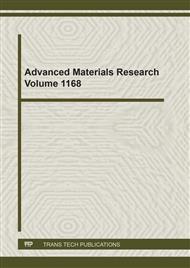p.11
p.23
p.35
p.49
p.75
p.93
p.115
p.123
p.139
Non-Destructive Evaluation of Mixing and Defects of Friction Stir Welded Dissimilar Aa6061-T6 and Az31b by X-Ray Computed Tomography
Abstract:
As a non-destructive evaluation method for friction stir welded joints, this research aims to develop and corroborate a method for material flow analysis and defect detection based on X-ray computed tomography (X-ray CT). Using a cylindrical FSW tool with a broad shoulder, joints of dissimilar materials AA6061-T6/AZ31b are friction welded employing tool rotary speed ranging from 1000 to 1500 RPM and tool feed from 125 to 400 mm/min. The welded joints are scanned via X-Ray CT with an image bit depth of 16-bit then segmented based on the Hounsfield Units scale (HU) and the global Otsu thresholding method. This segmentation divides the DICOM images into masks for each different material, from which 3D renderings are generated to record volumetric data. For analyzing elemental mixing, measurements of material penetration and transfer are carried out. Corroborating these results was accomplished using destructive cross-sectioning and Energy Dispersive X-ray Spectroscopy (EDX). The results show that this method can detect internal defects and characterize the material mixing with results comparable to that of destructive EDX analysis. The effect of improving scan resolution on reconstructed images was shown to slightly improve the accuracy of the thresholding method while reducing the standard deviation of segmented material ranges.
Info:
Periodical:
Pages:
115-122
Citation:
Online since:
January 2022
Authors:
Price:
Сopyright:
© 2022 Trans Tech Publications Ltd. All Rights Reserved
Share:
Citation:


